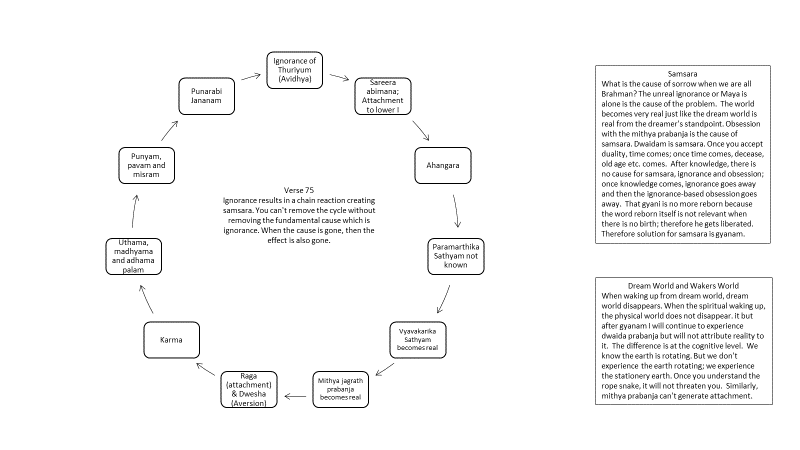Mandukya Upanishad, Class 78
Class
78
In versees 87, 88 and 89 Mandukya
upanishad was summarized. The teaching is that the avasthasthrya sakshi
is none other than Brahman. The sakshi is thuriyum and knowing the
thuriyum alone gives moksha.
In the 90th verse, Gowdapadha talks
about sadhanas to be followed. The four factors to be followed before
starting the sadhana. The four facctors are:
- Heyam (mithya vasthu): The prabanja is mithya and
only atma is sathyam; everything else is mithya and anatma. Nothing
wrong dealing with anatma because life is nothing but interacting with
anatma. But one should not be totally dependent on anatma and seek
security, poornatvam and ananda. Everyone seeks these three, but
anatma or mithya prabanja can’t give. Reject (don’t emotionally
depend on) the anithya mithay vasthu. - Yeyam or vigyeyam: (Sathya vasthu): What is
the ultimate thing to be known and relied upon. Thuriyum.
Learn to lean up on the sathya vasthu. - Apyam: To discover and rely upon atma;
sadhana sadhusta sambadhi; sravanam, mananm and nidhidhtyasanam; acquiring
a guru - Pakyam: That which has to be rendered
ineffective. Roasted seeds do not sprout; they will be tasty to
consume but they will not germinate. There are certain tendencies in
our mind, but we can’t remove them. We can roast them, so they won’t
cause problem. These are the fundamental nature of raga dwesha; we
all have natural likes and dislikes. Adharmic raga dweshas should be
eliminated right away. Other ragah dweshas reveal my individuality;
they are not adharmic; example food preferences; you do not need to
eliminate them. Make sure those raga dweshas are non-binding;
binding ragadwesha is one where if it is not available, I become
miserable; these are obstruction to spiritual growth; non-binding
ragadweshas are one I accept by choice. These must also be dharmic.
Practice all these four and come to
the dependence of thuriyum, which is self-dependence or moksha.
Three of these, Heyam Apyam and
Parkya, are vyavakarika sathyam and are useful at the time of sadhana and
should be utilized temporarily. Yeyam or vigyeyam is the ultimate
reality. Once we attain this reality, we should not depend on the other
three. Dependent on sasthram, guru, baghawan as an object are all should
be temporary.
Verses 91 to 100 the conclusion of
the entire karika teachings. What vedanta wants us to communicate is that
every basic need we already have within ourselves. Struggle for security
and protection last throughout our life and all our actions are triggered by
this sense of insecurity. Protection from bayam is what we seek but our
very nature is abayam or security. The real I alone sustain the
world. The security is not only available within me but it is also not
available anywhere else.
After security, we seek poornatvam
or completeness. That is why we always we grab on to anything.
Grabbing and not giving up anything is what most of us do. Once I know I
have what I want. struggles in life will go away.
Verse 91
Every jiva by very nature is like
akasa. Common feature of atma and akasa.
- All pervading,
- Indestructible
- Accommodates everything
- Never polluted by whatever accommodated.
I am anadhi, without a beginning, as
atma. There is no question of rebirth, because it is valid only when
there is a first birth. At the level of atma, there is no plurality at
all. There is only one jivatma which is none other than paramtma.
We can count bodies etc. but chaithanyam is one and the same which enlivens everybody.
Verse 92
This atma swaroopam, is not only
wonderful, but it is also always evident. It is never covered at any
time. It is experienced by everyone all the time. Thuirya atma being
consciousness, consciousnesses being ever evident, everybody is experiencing
thuriyum all the time. The problem is not the lack of experience of atma
or consciousness; but we have attributed certain limitations to ever evident
consciousness. Our problem is the misconception of the limitation of the
body that we have attributed to the consciousness. Remove the limitation
that we have superimposed. The limitless consciousness I am. We
don’t require new experience; we only need to drop the super imposition.
The consciousness is clearly evident; there is no doubt at all. The
person who realizes this, will be ever free from stress, restlessness; will be
relaxed. Such a person alone is fit for mosha or immorality.
Verse 93
Similarly shanthi is not
something we need to acquire; that is my real nature from the beginningless
time. We are not working for mental removal of thoughts. If you
define shanthi as thoughtlessness, that will not be possible as you will not be
able to maintain thoughtlessness permanently. The function of the mind is
to entertain thought; life involves using the mind. Let the mind
entertain the thought, but the presence and absence of thought has nothing to
do with my real shanthi which belongs to atma. Therefore, ever free from
samsara. The so-called samsara is a vyavakarika event that can’t disturb
my real nature. This is true of all jivas and only some jivas have
claimed this nature; All the jivas are really only one.




